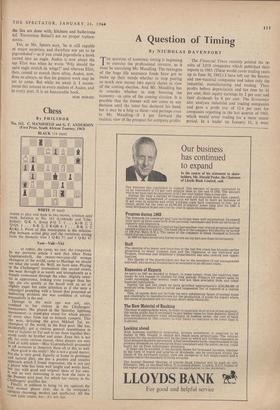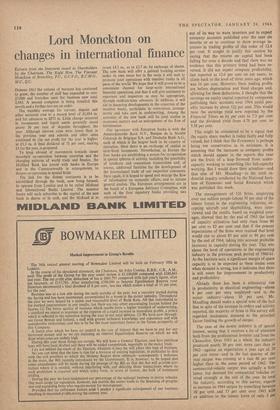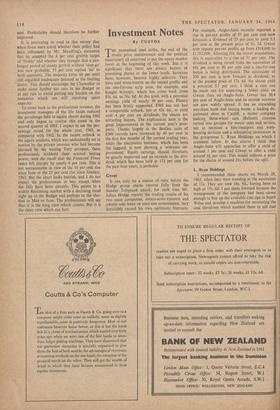A Question of Timing
By NICHOLAS DAVENPORT IHE question of economic timing is beginning to exercise the professional investor, as it must be exercising Mr. Maudling. The managers of the huge life assurance funds have- got to make up their minds whether to stop putting so much new money into equity shares in view of the coming election. And Mr. Maudling has to consider whether to stop boosting the economy—in spite of the coming election. It is possible that the former will not come to any decision until the latter has declared his hand, but it may be a help to them—and perhaps even to Mr. Maudling---if I put forward the realistic view of the prospect for company profits. The Financial Times recently printed the re- sults of 3,018 companies which published their reports in 1963. (These would cover trading years up to June 30, 1963.) I have left out the finance and raw-material companies and taken only the industrial, manufacturing and trading. Their profits before depreciation and tax rose by 41 per cent, their equity earnings by 2 per cent and their dividends by 6 per cent. The Economist also analyses industrial and trading companies and gave a profit rise of 12.4 per cent for companies reporting in the last quarter of 1963, which would cover trading for a more recent period. In a leader on January 11, it went out of its way to warn investors not to expect company accounts published over the next six months or so to continue to show average in- creases in trading profits of this order of 12.4 per cent. It sought to justify this caution by saying that the returns on capital had been falling for over a decade and that there was no evidence that this primary trend had been re- versed. It did not expect company profitability, last reported as 12.6 per cent on net assets, to climb back to the level of three years ago, which was 16 per cent. However, these trading profits are before. depreciation and fixed charges and, allowing for these deductions, it thought that the earnings on equity capital reported by companies publishing their accounts over 1964 could pos- sibly increase by about 12+ per cent. This Would raise the earnings yield now reported by the Financial Times as 6+ per cent to 7.3 per cent and the dividend yield from 4.78 per cent. to 5.38 per cent.
This might be considered to be a signal that the equity share market is today fairly and fully valued, but I think that the Economist is perhaps being too conservative in its estimates. It is assuming that the increases in company profits which should appear in the reports this year are the fruits of a leap forward from under- capacity working to something like full-capacity working. But I would draw their attention—and that also of Mr. Maudling—to the sixth in- dustrial inquiry conducted by the National Insti- tute of Economic and Social Research which was published this week.
The managements of 126 firms, employing over one million people (about 30 per cent of the labour force) in the engineering industries, ex- cepting aircraft and shipbuilding, were inter- viewed and the results, based on weighted aver- ages, showed that by the end of 1963 the level of capacity utilisation had only risen from 80 per cent to 82 per cent and that if the present expectations of the firms were realised that level would rise to about 85 per cent or 86 per cent by the end of 1964, taking into account probable increases in capacity during the year. This was about the level of operations in the engineering industry in the previous peak period of 1960-61. As the Institute says, a significant margin of spare capacity is to be expected in these trades even when demand is strong, but it indicates that there is still room for improvement in productivity and profitability.
Already there has been a substantial rise in productivity in electrical engineering—about 6 per cent per man employed—and in the motor industry—about 10 per cent. Mr. Maudling should make a special note of the fact that in spite of the increase in orders and activity reported, the majority of firms in this survey still regarded inadequate demand as the principal factor limiting the growth of output.
The case of the motor industry is of special interest, seeing that it receives a lot of attention both from the professional investor and from the Chancellor. Over 1963 as a whole the industry produced nearly 30 per cent more cars than in 1962—against an expectation a year ago of 20 per cent more—and in the last quarter of the year output was running at a rate 40 per cent higher than in the same period of 1962. The commercial-vehicle output was actually a little lower, but demand for commercial vehicles re- vived strongly at the end of the year. In total the industry, according to this survey, expects to increase its 1964 output by something between 10 per cent and 15 per cent over 1963 with an addition to the labour force of only 3 nor cent. Profitability should therefore be further improved.
It is interesting to read in this survey that when firms were asked whether their policy had been influenced by Mr. Maudling's statement that he accepted the 4 per cent growth target of `Neddy' and whether they thought that a pro- longed period of steady growth without `stop-go' was now probable, 75 per cent replied 'no' to both questions. The majority (over 60 per cent) still regarded inadequate demand as the limiting factor. This should encourage the Chancellor to make some further tax cuts in his Budget or at any rate to avoid putting any burden on the industries which are still reporting spare capacity. • To come back to the professional investor, the investment managers of the life funds reduced the percentage held in equity shares during 1962 and only began to reverse this trend in the second quarter of 1963. I expect to see the per- centage raised for the whole year, 1963, as compared with 1962. In the recent setback in the equity markets, which was undoubtedly set in motion by the private investor who had become alarmed by the waning Tory prospect, these professionals withheld their normal buying power, with the result that the Financial Times index fell sharply by nearly 6 per cent. This is not unreasonable in view of the 16 per cent rise since June or the 25 per cent rise since January, 1963. But the chart looks bearish, and I do not expect the professionals to buy except when the falls have been sizeable. This points to a widely fluctuating market with a declining trend right up to the Budget and perhaps to the elec- tion in May or June. The professionals will say that it is the long view which counts. But it is the short view which can hurt.




































 Previous page
Previous page